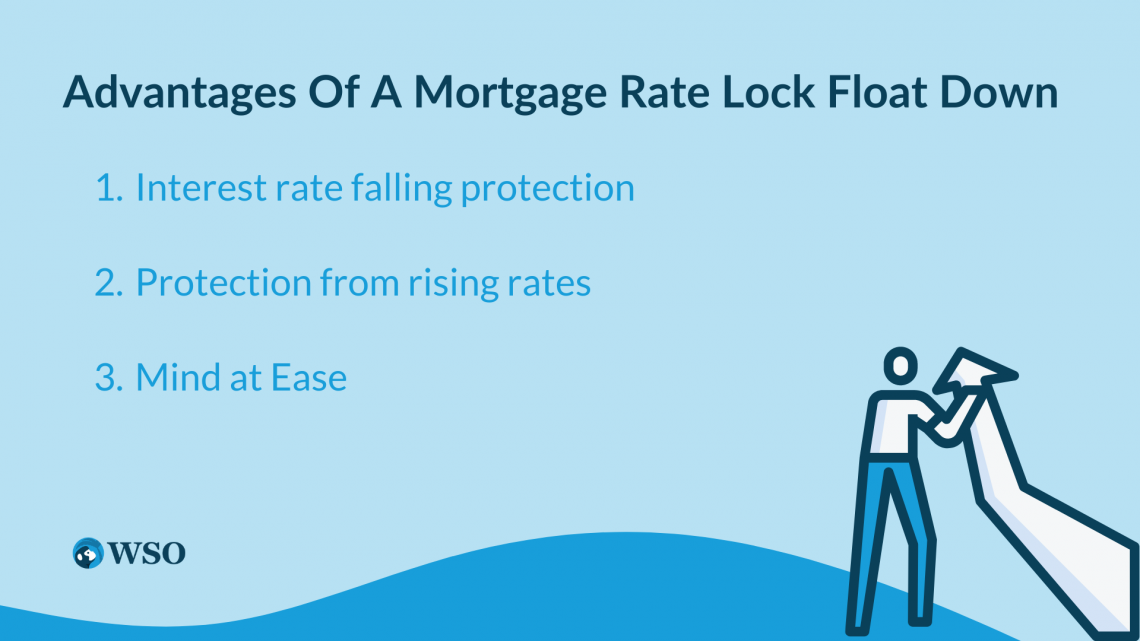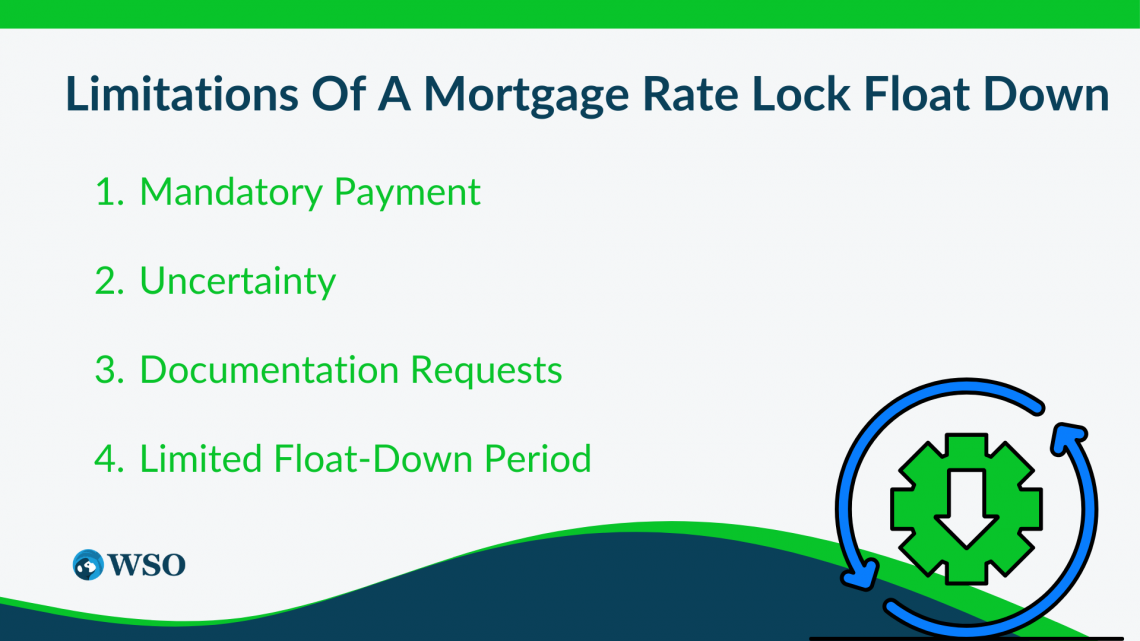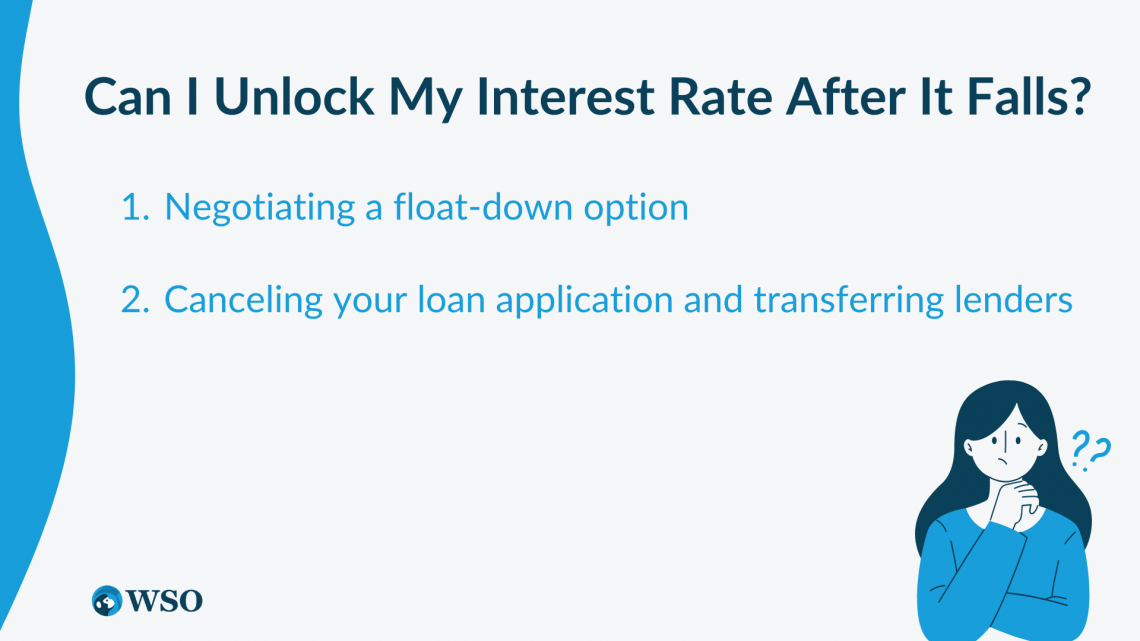Mortgage Rate Lock Float Down
Mortgage Rate float down gives the flexibility to lock interest rate when there is a dilemma about the fluctuating interest rate.
What Is a Mortgage Rate Lock Float Down?
Mortgage Rate float down gives the flexibility to lock interest rate when there is a dilemma about the fluctuating interest rate.

Mortgage interest rates significantly impact the purchasing cost, and payments that have been paid monthly will increase the housing market price. The goal is to obtain the lowest possible interest rate, allowing for significant savings.
A float-down option is available to borrowers in some mortgage loans that allows them to reduce their interest rate if market rates decline during the rate lock period.
It allows borrowers to secure a more favorable rate without the risk of missing out on potential rate decreases. This option protects borrowers from potential future rate increases while offering the flexibility to take advantage of lower rates.
Suppose there are changes to the information you supplied on your application for a rate lock, such as the property appraisal, credit score, income, employment, or any amendments to the loan, such as the length or type of mortgage. In that case, the rate lock may be void.
Key Takeaways
Understanding Mortgage Rate Float Down
Mortgage Rate float down gives the flexibility to lock interest rate when there is a dilemma about the fluctuating interest rate. Interest rates have the highest impact on the mortgage payment at the end of the term structure and the payment duration.

A float-down option offers the downside protection of securing from a significant loss by paying a higher interest rate. The following is the process to undergo while locking your interest rate.
- Lock your Mortgage interest rate.
- Keep an eye on the interest rate fluctuations subject to changes in economic, market, and lender behavior toward interest rates.
- If the interest rate has dropped to a specific requirement level that reduces the overall pay of the amount, then the borrower has to contact the lender to lock in the lower interest rate.
- Typically, the base pay range of the fee for a lower interest rate is between 0.5% and 1%
- The mortgage rate float-down option could be exercised if the interest rate decreases by a specific percentage.
- Examine the locked-in loan estimate.
- You'll get an updated loan estimate within three business days of locking your mortgage rate. Check whether the rate is accurate and that the closing fees linked with the rate have stayed the same.
- Lenders will lock interest rates for a certain period, from 30 days to 60 days, according to the customs bureau. Depending on the upfront fee, it can also extend from 90 to 120 days.
- If you close before the deadline, your mortgage rate will be guaranteed.
Mortgage Rate Float Down Eligibility
Even though the Mortgage rate float down has a downside protection, It follows an eligibility criterion that restricts every borrower from opting for this. Furthermore, using the Mortgage Rate Float Down option may incur fees or expenses, affecting the ultimate mortgage cost.

Before deciding to opt for the Mortgage Rate Float Down option, it is critical to properly research and understand its terms, conditions, and potential costs.
- Conditional approval is for your loan. Only when your loan has been accepted after assessing your credit, income, and assets does a lender's policy on "float-down" apply.
- A specific percentage must be taken off of your rate. Generally, you cannot float it lower if your rate decreases by more than a quarter to a half point.
- A charge will be incurred. You may be required to pay a fee of up to 0.50% of the loan amount since the lender must renegotiate your lock with the investor you have committed to.
- Before closing, the borrower must decide whether to activate or decline the float-down option. It's important to note that many lenders cannot extend the lock period for the float down, even if the closing date is pushed back.
Mortgage Rate Float Down Examples
When you apply for a home loan, the lender may give you a rate lock period that allows you to lock in an interest rate for a set amount of time. In this scenario, you were given a 60-day rate lock period with a 4% interest rate.

However, a few weeks later, you observe that market interest rates have dropped dramatically, and the lender is now offering new consumers a lower rate of 3.5%. Fortunately, your rate lock contract offers a float-down option.
If market interest rates fall during your rate lock period, you can take advantage of the reduced interest rate by drifting down. You decide to exercise since you have observed a drop in interest rates. You notify your lender of the rate decrease and your request for a float down.
The lender examines current market conditions and confirms interest rates have decreased. As a result, they agree to reduce your locked rate from 4% to 3.5%, giving you a lower interest rate on your home loan.
If your rate lock agreement includes a float-down clause, you can take advantage of a reduced interest rate if market rates fall over that time period. You could acquire the cheaper rate of 3.5% by exercising this option.
What Is The Price Of A Mortgage Rate Lock Float down?
Rate locks may have associated costs, although they are often included in the interest rate offered by the lender. Some lenders charge a fee for extending the rate lock period, typically around 0.375% of the loan amount.

For example, a 15-day extension on a $100,000 loan would cost $375. It's essential to inquire about potential extension fees and consider whether paying them upfront is more cost-effective if rates increase.
In the case of construction loans, lenders may charge a fee for providing extended-rate locks during the home development process.
In addition, you must reach the expiration date of your rate lock to avoid being charged a rate lock extension fee.
Lenders may charge a fee for prolonged rate locking during the home construction process in the case of construction loans. You may be charged a rate lock extension fee if You must fulfill your rate lock's expiration date to avoid being late.
Note
Discussing your loan officer's rate lock extensions and relock fee policies is critical.
To determine when to lock the rate, you should know the expected closing date of your loan and work backward. It's advisable to provide yourself with some extra time.
For instance, if you anticipate a 45-day closing process, you could inquire about the interest rate and cost for a 60-day rate lock period.
When To Consider Mortgage Rate Lock Float Down?
Float down option isn’t one size fits all. The length of your stay in the house is one of several variables that affect whether you choose to use a float-down option. It is best to contact your lender about the float-down option before settling your interest rate.

This will assist you in understanding the precise restrictions and potential charges. Having the lowest interest rate has become more important when the plan is for the long term.
In a 30-year mortgage, a small change in interest rate can have a major impact even when the interest rate has a reduction of 0.5%
You have the choice to lock in a rate and pay for the float-down provision if you are concerned about prospective interest rate swings and wish to reduce the danger of rates rising.
Observing your area's mortgage rate is recommended between pre-approval and submitting a mortgage application. Obtaining advice on this topic from your real estate agent and loan advisor is worthwhile.
Note
It is recommended to lock your interest rate when there is a sign of an interest rate increase in the mortgage. You may not use the rate lock if rates are falling.
With this strategy, you may safeguard against interest rate increases while simultaneously taking advantage of cheaper rates when they become available.
Advantages Of A Mortgage Rate Lock Float Down
There are many advantages to opting for a mortgage rate float down. Some of them are discussed below.

1. Interest rate falling protection
A float-down option lets borrowers lower their mortgage expenses if interest rates decline. This provision allows borrowers to request a rate adjustment to take advantage of a lower rate during a specific period if rates have dropped since they initially locked in their rate.
By exercising the float-down option, borrowers have the potential to reduce their mortgage costs and save money on their monthly payments.
2. Protection from rising rates
A mortgage rate lock float down offers borrowers protection against rising interest rates. If rates increase after the borrower has locked in their rate, they can keep the lower rate they initially secured.
Note
The protection safeguards the borrower from higher rates in the market and ensures they can proceed with the more favorable, initially locked rate for their mortgage.
3. Mind at Ease
Locking your rate now, you may protect yourself from future rate increases. Simultaneously, you can take advantage of cheaper rates as they become available.
If mortgage rates fall significantly after you lock in your rate, you can use the float-down option to get the lower rate. This option gives you the possibility of benefiting from a lower interest rate.
Limitations Of A Mortgage Rate Lock Float Down
While the Mortgage rate float down is beneficial, it has downsides to consider before choosing the option. The following are the cons of the Mortgage rate float down.

1. Mandatory Payment
Borrowers need to understand that regardless of whether they utilize the float-down option, they may still be responsible for paying the fees related to this provision.
These fees are typically incurred when securing the mortgage rate lock and are separate from any potential adjustments to the rate itself.
Note
Borrowers should know that the float-down option comes with associated fees, regardless of their decision to exercise it.
2. Uncertainty
Many borrowers decide to include float-down clauses in their mortgage agreements because they believe interest rates will eventually decrease. This choice may have been made as a result of persistently declining rates.
Note
Borrowers should exercise caution, though, as they can unintentionally add a float-down option if they think the trend of falling rates will continue.
3. Documentation Requests
The lender may request extra documentation or verification if the float-down option is activated. This might cause delays and potential issues in the mortgage process, especially if there are strict documentation requirements or you are on a tight timeline.
4. Limited Float-Down Period
The float-down option may be available for a limited time frame. This implies that you must closely monitor the market and make a decision within that time frame. If you miss out on this chance, you may be unable to take advantage of future rate reductions.
When To Lock The Rate In A Mortgage Loan?
Depending on the lender, the timing of mortgage rate locking can vary. Specific lenders may offer a rate lock option as soon as the applicant achieves pre-approval, even if the only information provided is the address of a potential house.

On the other hand, some lenders may require the seller to accept the buyer's offer before giving a rate lock. Lenders' specific policies and practices regarding rate locking may differ.
You can choose when to lock the interest rate on your mortgage loan, typically anytime between initial loan approval and five days before the closing.
In some situations, lenders may choose to lock your rate while giving you a loan estimate. It is critical to remember that once the rate lock term expires, your loan's interest rate may begin to alter.
Note
Being aware of this potential change is critical to making informed judgments about when to lock your rate and apply for a mortgage.
To ensure a lower interest rate and annual percentage rate (APR) for your new mortgage, it is crucial to time your mortgage rate lock effectively.
With RateShield®, unlike most rate lock options, you can secure your rate by making a one-time payment and keeping it frozen for up to 90 days while you search for a house.
Can I Unlock My Interest Rate After It Falls?
It is impossible to unlock the interest rate after it falls while there is an option to lower it significantly. Some of the options are:

1. Negotiating a float-down option
One technique to consider is negotiating a "float down option" with your lender. This option permits you to pay a higher closing fee in exchange for locking in the current lower market rates if they become available during the process.
The float-down option allows you to capture a lower interest rate if rates fall between the time of your rate lock and the closure of your loan.
Note
Lenders have their rules and qualifying standards, so it's critical to understand the precise conditions and potential expenses involved with this choice.
2. Canceling your loan application and transferring lenders
Alternatively, consider canceling your loan application and transferring lenders. This entails restarting the loan process with a new lender with a lower interest rate. You can take advantage of a better rate if you do so.
However, it's critical to consider the potential costs and effects of switching lenders, such as application or processing fees, additional documentation requirements, and the influence on your loan closing timetable.
What To Do If My Mortgage Rate Lock Expires Before Closing?
If your mortgage rate lock expires before closing and rates rise, you will normally be obligated by the terms of the locked rate, requiring you to pay the higher loan rate. You must accept the higher interest rate to meet your debt obligations.

On the other hand, if your rate lock period expires and rates have dropped, you won't automatically receive the reduced rate. You will proceed with the closing based on the initially locked rate.
It's essential to understand that if interest rates have increased after the initial rate lock period, many lenders may offer customers the choice of a rate lock extension, which allows you to extend the rate lock period and maintain the originally agreed-upon rate.
Note
Depending on the lender's policies, you might be able to pay a closing extension fee in specific circumstances instead of accepting the higher rate.
It's crucial to carefully review the terms and conditions of your rate lock agreement, consult with your lender or mortgage advisor, and consider the current market conditions before making decisions regarding rate lock extensions or accepting higher rates due to expired lock periods.
Is It Worth Having The Mortgage Interest Rate Lock Float Down?
A mortgage interest rate lock is generally worth it because the benefits outweigh the risks. The primary purpose of a rate lock is to protect your home buying power rather than securing the absolute best mortgage deal.

By locking in the interest rate, you can prevent any potential rate hikes before the closing of the mortgage.
If you choose not to lock the rate and the interest rate increases, you may need to create a higher down payment. For example, Consider having a house of 30 years for $500,000 at a 4% interest rate and just paying a 20% down payment.
A 0.25% rise in the interest rate would significantly increase by $58, from $1,910 to $1,968. This increase will total more than $3,480 if you only intend to live in the residence for five years. The cost of locking in the rate, typically around 0.25%, would only be $1000.
During the 6 to 8-week closing period, the interest rate can fluctuate more than a quarter point. Without a rate lock, you risk facing even more significant increases.
Summary
To summarize, a mortgage rate float-down option is a valuable resource for borrowers in particular circumstances. It offers flexibility, protection from interest rate increases, and the chance to benefit from cheaper rates if they become available while the rate lock term is in effect.

Borrowers can lower their monthly payments and mortgage costs using the float-down option, resulting in long-term savings.
But, borrowers must consider the expenses and thoroughly assess their circumstances.
With the interest rate swings, the anticipated length of stay in the home and potential savings from securing a lower interest rate should all be considered when deciding whether to employ the float-down option.
Note
Borrowers should be aware that they may still be responsible for fees related to the float-down provision, regardless of whether they exercise it.
The worth of a mortgage rate float-down option ultimately depends on the circumstances and choices of the individual. Borrowers can make a decision that is in line with their financial objectives by seeking advice from a lender and the conditions of the float-down provision.
Furthermore, fixed-income investments are renowned for their benefits to diversification. They may be used to balance a portfolio of investments, including higher-risk assets like equities and their risk exposure. Investors can lower overall volatility and limit possible losses during market downturns by including fixed-income assets in their portfolios.
Researched and Authored by Lavanya Purushothaman | Linkedin
Free Resources
To continue learning and advancing your career, check out these additional helpful WSO resources:









or Want to Sign up with your social account?